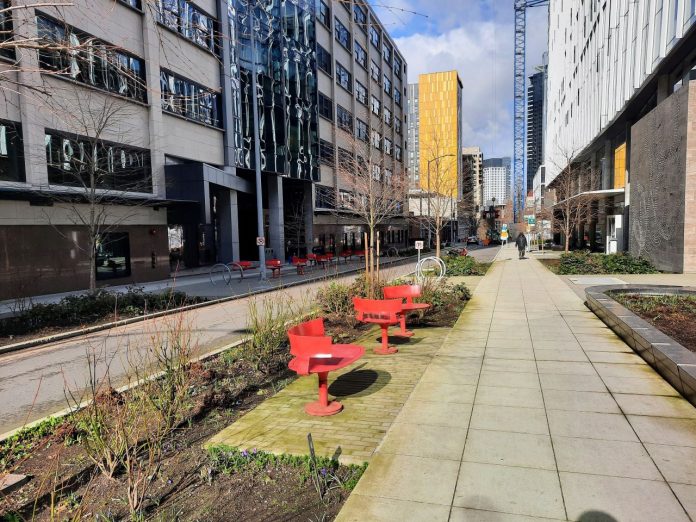
All urban design and architecture is implemented with a particular goal in mind — often to shape people’s behavior in a particular direction. Hostile architecture, also known as unpleasant or exclusionary architecture, or defensive urban design, is a type of design which “uses elements of the built environment to guide or restrict behavior,” particularly relating to elements that are intended to stop people from doing something.
It is usually used for preventing damage to property, limiting particular uses of public space (such as preventing skateboarding), or stopping homeless people from sleeping or resting in public spaces. It has also been applied in service of segregation and racial discrimination.
What defines hostile architecture?
Hostile architecture can, at times, be difficult to describe. Robert Rosenberger, an associate professor at the School of Public Policy at the Georgia Institute of Technology describes it as an “interdisciplinary topic” in a relatively new field of research. In addition, he says that “keeping it kind of invisible to most people is part of the larger strategy.” This means that elements of hostile architecture might be hard to spot.
Many of the urban design choices for hostile architecture include the use of anti-homeless spikes, bars on park benches, locked park gates, or bright lighting in subway alcoves. As these mechanisms don’t affect most people, they may go unnoticed. There are also more subtle design elements such as locks on fire hydrants, which can particularly affect people in already-overheated poorer areas, and prevent them from cooling down on hot days.
Rosenberger notes that hostile architecture is often (though not always) being carried out by “powerful people putting in the design to stop the behaviors of the less powerful people,” limiting the uses of public space for already-disadvantaged groups. However, as Karl de Fine Licht, senior lecturer at Chalmers University of Technology in Sweden, explains in his research, skateboarders are not particularly disadvantaged, and the needs of the public must always be considered in light of the needs and benefits of all people who use that public space.
For example, it may affect a homeless man negatively to not be able to sleep in a bus shelter, but it also affects bus riders (who statistically come from lower socioeconomic groups) when they cannot use the shelter because someone is sleeping there. When considering the use of public space, de Fine Licht explains that often “there is a balance between two less well-off groups” that has to be determined.
Seattle bike infrastructure

One common application of hostile architecture is anti-homelessness measures. In Seattle, the Seattle Department of Transportation (SDOT) undertook two different design choices that were widely reported as suspected hostile architecture.
The first of these was the placement of bike racks under an overpass, in an area where homeless people were likely to sleep, but where there was very little need for bike racks. The strange positioning of the bike racks indicated their true function: to prevent unhoused people from lying down or camping underneath the bridge. This is one way in which hostile architecture hides in plain sight: The use of otherwise normal or even beneficial infrastructure can be applied for ulterior motives, as a way of restricting use of public space by particular groups of people. Ultimately, the backlash against their hostile use led SDOT to remove the set of bike racks in question.
A further example of the use of bike infrastructure as hostile design is the SDOT replacement of an RV camp with a bike lane. While the addition of a bike lane in urban areas is important, in this case the planning was unannounced. This led to widespread suspicion about the bike lane, and questions about whether it was being employed as a tool to push RV campers out.
As Rosenberger says, the use of public space is complex: in all design decisions there is a question of “what public space means, and who gets to count as the public,” a debate that is still “up for grabs.” In addition, de Fine Licht says that certain political groups such as populist right wing parties also “typically see the disadvantaged to be responsible for their misfortunes and thereby a legitimate target of such design.”
Road closures and design

A historical example of hostile architecture in Memphis shows the ways in which urban design decisions can also contribute to, or enact, racism and segregation. In the 1970s, West Drive connected Hein Park, a predominantly White Memphis neighborhood, and Hyde Park to the north, a predominantly Black one. Residents in the Hein Park neighborhood petitioned for West Drive to be closed at the north end, under the guise of preventing through-traffic. This petition was granted, and the road was closed. A court later found that the road closure was a way of discriminating against Black residents in Hyde Park, and particularly that it was a “unique step to protect one neighborhood from outside influences which the residents considered to be undesirable.”
Rosenberger notes that the impacts of such decisions are not only historical: In Atlanta in the 1970s, the proposed extension of MARTA subway lines into the suburbs was much decried by racist suburbanites, who did not want the typically Black urban dwellers to have access to the outer suburbs. Nathaniel Smith, founder of the Partnership for Southern Equity, an Atlanta-based nonprofit, writes that the transportation landscape in Atlanta has “been undeniably shaped by a history of structural racism and divisive policy decisions,” leaving inequality present today.
Rosenberger explains that hostile architectural design decisions can effectively do “the same thing as regulations but they’re not subject to the same mechanisms of approval,” leaving people facing discrimination that operates at an infrastructural level rather than a legal or regulatory one, with fewer routes for resolution.
Camden benches

Another example of hostile architecture is the design of so-called Camden benches in Camden, London. These benches were created in 2012, and were specifically made “to resist criminal and antisocial behavior.” They are able to be sat on or used for brief periods, but due to their design cannot be slept on. Their lack of holes or crevices prevents drugs from being stored inside them, and the surface design is intended to prevent littering. The BBC has described these benches as a “masterpiece in unpleasant design,” especially given that they are also not comfortable to sit on.
Camden benches are just one instance of seats that are designed specifically to prevent certain behaviors. Others include benches with large arm rests segmenting the bench into pieces to prevent homeless people from lying down, or heavily-sloped surfaces so that they can only be leaned on. Alternative designs include “anti-skate bars,” which break up the smooth surface of the bench’s edge so that skateboarders cannot grind along the side.
In other cases, infrastructure is also not installed, leaving hostile infrastructure invisible. As de Fine Licht says, “when you design a square, for instance, there are a lot of things you can do but choose not to because that might attract ‘the wrong people.’” This could be, for example, choosing not to install a pavilion or roofed area, to prevent people from gathering or sleeping under it. As de Fine Licht explains, “the absence of a roof is hard to see.”
Encouraging social behavior
Urban design can also be used to encourage positive behaviors in public spaces, including promoting social interaction and connection. For example, bike lanes and walkways can be established that connect diverse neighborhoods, and parks can be established with free water fountains, sufficient benches, and structures such as pavilions, children’s playgrounds, and restaurants.
One example is the Klyde Warren Park in Dallas, which has numerous amenities and park services, including what they describe as a “firm but fair” policy for handling park behavior. A team of undercover reporters even posed first as a homeless man, and then as a man in a suit, and in both cases lay on benches around the park to see how it would be handled. Regardless of appearances, park patrollers simply asked the reporter to sit up instead of laying down, so as not to prevent other park users from using the bench. This is one way of allowing public space to still be usable by anybody in the space, without pushing homeless people out of the park or employing hostile design elements.
Urban design can also be used to create human-centered spaces by employing elements that prevent or limit car access, and make things more accessible for people. This can include flat paths and low curbs, bollards to stop excess through-traffic, removing parking spaces, and installing more benches, public toilets, and trees for shade. While hostile architecture is one form of design, it is far from the norm: de Fine Licht says that “urban planners are trying all the time to create possible meeting places for people from all walks of life.”
All urban design choices have impacts on the people who live in our cities, and it’s crucial to get the balance right. When facing problems such as high levels of homelessness, it’s also necessary to consider the larger solution: Hostile architecture doesn’t really solve anything, and rather simply pushes the problem elsewhere. What’s more is that it can be hard to see, and most people don’t think about how their behavior is being shaped by the urban landscape around them. Part of what we can do next, Rosenberger says, is concentrate on the solutions to those larger problems one step at a time.
Leah Hudson Leva is an editor and writer published by Insider, Atlas Obscura, and Penguin Random House New Zealand. Leah loves to write about sustainable urban development, mental health, and matters of the heart. She spends her time reading, walking her dog, and eating unreasonable amounts of chocolate. You can find her at https://leahhudsonleva.com/.


